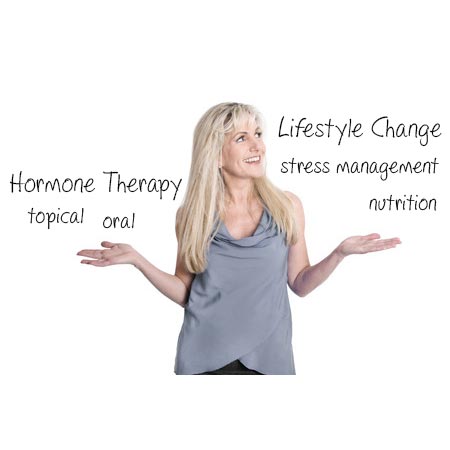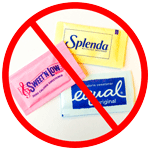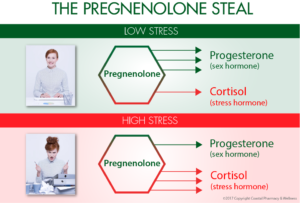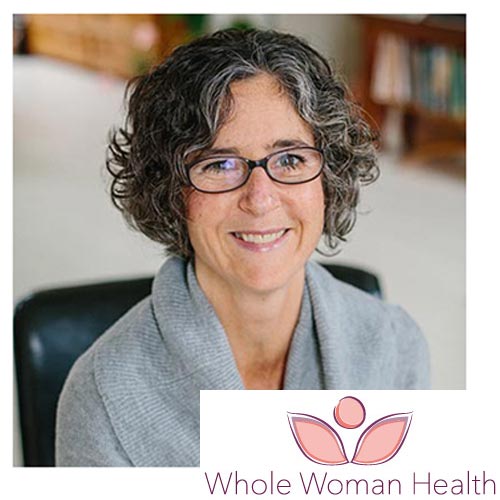
I spend a lot of time talking with women about hormone balance. Here is the one thing I know for sure: The way to hormone balance is different for each of us. Nothing illustrates this more clearly than the findings of the Women’s Health Initiative: The one- size-fits-all synthetic hormone therapy of the 1990s proved to be unsafe. The lesson learned from that study is practitioners cannot put all women on the same dose of the same medicine and expect everyone to feel well. Nope. It just doesn’t work that way.
A Lifestyle Change May Be in Order
When I talk with women about hormone balance, I talk about a continuum of options. Doing nothing is always an option. For some women, hormone imbalance is tolerable. For the women who find their symptoms of hormone imbalance intolerable, I discuss nutrition and exercise. Three healthy eating habits promote hormone balance: 1) eating lots of vegetables; 2) limiting simple carbohydrates like bread, cereal, and pasta; and 3) getting adequate protein, either from organic animal or plant sources.
 There’s one more important dietary change that could impact your health in significant ways: eliminating artificial sweeteners. It is one of simplest slash-and-burn approaches to decreasing inflammation. Artificial sweeteners are not food—they are chemicals. Our bodies recognize them as foreign and elicit an immune response against them. Artificial sweeteners are the only ”food” I advise women never, ever, to eat.
There’s one more important dietary change that could impact your health in significant ways: eliminating artificial sweeteners. It is one of simplest slash-and-burn approaches to decreasing inflammation. Artificial sweeteners are not food—they are chemicals. Our bodies recognize them as foreign and elicit an immune response against them. Artificial sweeteners are the only ”food” I advise women never, ever, to eat.
Managing stress in healthy ways, i.e. without alcohol, drugs, and other addictive substances and behaviors has a direct effect on hormone balance. Our ovaries are the primary production site of our hormones. Our adrenals, small glands right above our kidneys, primarily make cortisol and other stress hormones. However, the adrenals secondary job is to make sex hormones. Postmenopausal women and women who have had complete hysterectomies still have some hormone production because of the adrenals. If our adrenals are burdened by stress and are consumed with full-on, 24/7 stress hormone production, they can’t efficiently make the sex hormones. When our adrenals don’t have to make lots of stress hormones, they make our sex hormones and thereby minimize the symptoms of hormonal imbalance. So take a walk, pray, meditate, see a friend, have a nap. Your adrenals will thank you, and you will help your hormones balance.
The Cortisol-Pregnenolone Connection
There is a phenomenon known as ‘the pregnenolone steal’ that is key to understanding the relationship between stress and hormone balance. The concept is this: Cortisol is our primary stress hormone. It is made in the adrenal glands. Its biochemical precursor is pregnenolone. Pregnenolone is also the biochemical precursor to progesterone, the mother of the sex hormones. So, when there is chronic stress and the demand for cortisol is constant, there is not enough pregnenolone left to make the sex hormones. The net result is hormone imbalance. This is part of why we skip our periods when stress levels are elevated.
Stress = Imbalance
So, the take-home message is this: It is NOT physiologically POSSIBLE to have balanced sex hormones under the conditions of chronic stress. THEREFORE, developing healthy stress management coping skills is essential to hormone balance. There is no medication or supplement that can right this. Both can help, but neither can get to the root cause of the imbalance.
Natural Modalities for Relief
Nutrition, exercise, and healthy stress management are the foundation for hormone balance. There are a variety of other modalities that offer women relief from symptoms of hormone imbalance, like acupuncture and Chinese herbs.
There are many botanical remedies and supplements for hormone balance available at health food stores, like Coastal Pharmacy & Wellness, and online. Some remedies and supplements are supported by clinical data and others are not. Nutrients that have clinical data supporting their efficacy in balancing hormones include indol-3-carbinol, omega 3 fatty acids, resveratrol, and probiotics.
Hormone Therapy
If the latter interventions miss the mark and a woman is still struggling with her quality-of-life, then oral contraceptive pills (OCPs0 or hormone therapy (HT)) are options. It is generally not advised to administer OCPs to women over the age of 50 due to the relatively high levels of synthetic estrogen found in the pills and the risk of stroke. OCPs are not my first go-to for hormone support for multiple reasons. First, hormones in OCPs are synthetic, which means part of them is recognized by the body as foreign. Second, hormones are first broken down in the gut. If your gut is out of balance, you cannot properly metabolize your hormones. Third, hormones go from the gut to the liver, where estrogen is broken down into metabolites. There are health-protective metabolites and metabolites that increase the risk for disease. Metabolites of synthetic hormones can potentially increase the risk for disease. There are also multiple enzymatic processes that drive detoxification pathways in the liver. Our genes drive these processes. If you are missing one or more genes, you may not break down hormones optimally, thereby increasing your risk of side effects associated with hormone therapy.
Hormone Therapy Applied Through the Skin
Research supports the safety of bio-identical hormone therapy given through the skin, for the shortest duration of time necessary, at the lowest therapeutic dose. When hormones are given through the skin, they bypass the gut and liver, thereby decreasing the potential production of disease-producing metabolites. Using the lowest dose for the shortest duration of time decreases the overall lifetime exposure of estrogen, thereby potentially decreasing estrogen-based diseases.
When I prescribe hormone therapy, I typically start with a transdermal patch of estrogen and compounded progesterone. I am always surprised when women come to me for bio-identical hormone therapy after requesting it from a practitioner, who responded with something like, “I don’t dabble in that.” While it’s great they’re honest about their lack of experience, hormone therapy is a powerful tool that should be in every practitioner’s toolbox. If they don’t have the expertise, they should be prepared to refer you to someone who does. There are multiple preparations of bio-identical estrogen that are part of the standard formulary. Two examples are Climara and Minivelle. These transdermal patches are both made with 17-beta estradiol, which is biochemically the same as the estrogen we make. Prometrium is a bio-identical progesterone pill suspended in peanut oil that is part of the standard formulary. This is not my first choice because it’s an oral pill, and my goal is to give hormones through the skin. The cost of compounded progesterone cream or rapid dissolve tablets is often equivalent to the co-pay for Prometrium. You can discuss this with a pharmacist at Coastal.
Monitor Your Levels During Therapy
I encourage women using hormone therapy to test their serum levels of hormones annually. For me, this is part of ”doing no harm.” I want to make sure the woman feels well AND that things look good on paper. I recommend a blood test through a functional lab that measures the estrogen metabolites made in the liver. I can evaluate whether an individual woman’s body is creating more health-protective metabolites or more metabolites associated with estrogen-dependent disease. If she is producing more metabolites associated with an increased risk for estrogen-dependent disease, we want to both know and do something about it! What is there to do? Eat more leafy green vegetables, supplement with a broccoli seed derivative, and/or increase aerobic exercise, and discuss whether the potential gain of hormone therapy outweighs the risk.
The Take-Home Message: Do What’s Right for You
I’ve encountered two different guiding philosophies in regard to hormone therapy. One philosophy is as I stated above: Give the lowest dose necessary to address the symptoms. The other approach I associate with the anti-aging movement: Get your hormone levels to where they were at the age of 30 in order to achieve optimal wellness, avoid diseases related to aging, and slow the aging process. I find women vary in their personal approach to hormone therapy. I work to honor whatever the individual woman’s philosophy is.
Hormone levels decline as we age. This is the natural order of things. Some women can not, or do not want to, accept their symptoms of hormone imbalance. It is up to each individual to decide where her threshold of tolerance lies. Working with a licensed practitioner who deals with each woman’s biochemical individuality is key to achieving successful hormone balance. With education, guidance, and comprehensive health care, women can achieve the hormone balance they desire in a way that feels good to them.
Additional Resource
For more information on compounded hormone therapy, visit https://www.coastalpharmacyandwellness.com/compounding-custom-tailored-hormone-therapy.



